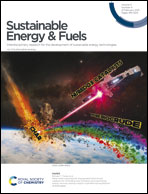Alternate cycles of CO2 storage and in situ hydrogenation to CH4 on Ni–Na2CO3/Al2O3: influence of promoter addition and calcination temperature†
Abstract
Alternate cycles of CO2 adsorption and in situ hydrogenation to CH4 using dual function materials (DFMs) allows eliminating the intermediate and expensive CO2 purification step. Several DFMs with composition 10% Ni–10% Na2CO3 have been synthesized by wet impregnation and subsequent calcination in an extended range of temperatures. Then, the influence of the addition of low quantities (1 wt%) of promoters, such as La, Co, Fe, Ca, Ce, Ru, Pd and Mn, has been studied. All prepared samples were characterized, and the influence of calcination temperature and the nature of promoters on the catalytic behaviour has been analysed and related to the physicochemical properties of the prepared samples. A higher calcination temperature reduces the specific surface area and modifies metal–support interaction, promoting the sintering of nickel with the consequent reduction of metal dispersion; also the basicity and reducibility of nickel species are reduced. The trade-off between calcination temperature and reactivity is discovered and resolved for efficient CO2 adsorption and in situ hydrogenation. An optimal calcination temperature of 550 °C achieved the highest production of CH4 per cycle (177 μmol g−1) with high selectivity (90%). On the other hand, the addition of promoters (1 wt%) generally increases the catalytic activity without noticeable changes in the physicochemical properties of the samples, with the exception of ruthenium, which notably enhanced dispersion and reducibility. The sample 10% Ni–10% Na2CO3(1% Ru)/Al2O3 boosted the production to 266 μmol g−1 of CH4 per cycle, also maintaining higher selectivity. Ru-promoted and non-promoted samples showed stable CH4 production during long-term experiments. However, CH4 production was significantly reduced when oxygen was included in the CO2 adsorption step. It was possible to partially recover the activity of the catalyst after a long regeneration period or by removing oxygen from the feed, especially for the Ru-promoted sample.



 Please wait while we load your content...
Please wait while we load your content...